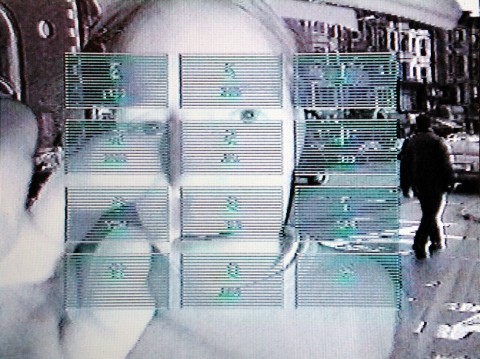Artist and UT Austin professor Kristin Lucas’s work explores the effects of various digital technologies on the cultural consciousness in video, installation, and performance art. She explains, “As a woman, I am creating a discourse within which to elucidate my relationship toward the electronic dream. I unravel the complexity of this relationship by setting up virtual interactions with mediated devices, such as automated tellers, public access television, computer games, and the World Wide Web.” In her video Host (1997), Lucas also conveys the intricacy—the desire, isolation, and frustration—many users experience in the digital world. While engaging new media for her own artistic purposes, she emphasizes the ambivalence many of us feel toward the technology that we both rely on and recoil from.
Born in Davenport, Iowa, Lucas earned her BFA at Cooper Union in 1994. She worked as an assistant to video art pioneer Tony Oursler before attending graduate school at Stanford University, where she earned her MFA in 2006. In Silicon Valley, Lucas was immersed in a hotbed of technological activity that informed her practice and produced many of the programs and platforms seen in Host that have revolutionized our daily lives.
In grainy black-and-white footage, the video begins with the view from a camera within a street kiosk surveilling a busy street intersection. The artist approaches the screen, where she is instructed by an automated voice to enter an access card and identifying information. As she is reduced to numbers and codes, Lucas repeatedly attempts to make a connection with the operator within the machine, who is also played by Lucas costumed in a uniform with helmet, goggles, and microphone. Lucas the operator continually yells directions as she conducts the flow of myriad programs, including sports competitions and video games, while serving as “host” and therapist to the former Lucas.
Lucas the user/client thoughtfully speaks about the breakdown of her relationship with a person…or a machine. The distinction is blurred in her description of feeling depressed after she spent time and money on an “upgrade” when she thought the relationship was becoming stagnant. Now things are moving too fast. The couple no longer spend hours together, only minutes, and Lucas wants things to slow down. The upgrade has not been an improvement, but rather has permitted the flow of more data, thus confusing, not clarifying, the situation. Worst of all, Lucas was told she was dead when she went in for a “tune-up,” despite having received a new life on “level two.”
The conflation of human and machine and the confusion between technical and psychological advice is underscored by the cacophony of smash cuts between scenes of Lucas the system operator and Lucas the user/client, along with periodic haunting shots of the artist’s disembodied, dissected face. Within the chaos of the session, Lucas thus centers her own figure and experience. The confessional format of Host makes her flesh, voice, and feelings integral to the activity onscreen. It insists on humanity within the digital world, which is conceived, created, experienced, and affected by people, impressing upon viewers the real-life stakes of the technological mediation of our personal interactions.
Host, therefore, was prescient in the late 1990s and remains relevant in the early 2020s, particularly during and after the pandemic when much of the world relied on online communication and virtual meetings to conduct business and maintain relationships. Web therapy platforms also abound, such as Betterhelp and Talkspace, in which introspection can take place on the go, in the street, amid sounds of barking dogs and driving cars, similar to the therapy session in Host. Despite the chaotic conditions, Lucas’s experience rings true, suggesting a sense of loss and a desire for connection in our hyper-mediated lives. —Kanitra Fletcher

